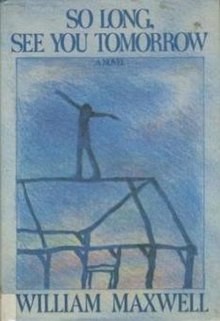So Long, See You Tomorrow is a novel by American author William Maxwell. It was first published in The New Yorker magazine in October 1979 in two parts.[1][2] It was published as a book the following year by Alfred A. Knopf.
 First edition[a] | |
| Author | William Maxwell |
|---|---|
| Cover artist | Brookie Maxwell[a] |
| Language | English |
| Publisher | The New Yorker (magazine) Knopf (book) |
Publication date | 1979 (magazine) 1980 (book) |
| Publication place | United States |
| Media type | |
| Pages | 135 |
| ISBN | 0-394-50835-1 |
It was awarded the William Dean Howells Medal,[3] and its first paperback edition won a 1982 National Book Award.[4][b] It was a finalist for the 1981 Pulitzer Prize.[5] Michael Ondaatje described it as "one of the great books of our age".[6] In 2016, it was included in a Parade Magazine list of the "75 Best Books of the Past 75 Years".[7]
The novel is based on fact and has been described as an "autobiographical metafiction".[8]
Plot introduction
editSo Long, See You Tomorrow is set in Maxwell's hometown of Lincoln, Illinois and tells of a murder that occurred in 1922. Fifty years later the guilt-ridden narrator recounts how the relationships between two neighboring families—the Smiths and the Wilsons—led to the murder of Lloyd Wilson and the suicide of Clarence Smith. Also the narrator recounts how he failed to support Cletus, a close school friend who was the son of the murderer, Clarence Smith.[9]
Critical reception and influence
editOn November 5, 2019, the BBC News listed So Long, See You Tomorrow on its list of the 100 most influential novels.[10] In a starred review, Kirkus Reviews stated that the book was "major accomplishment: a wellnigh faultless, lacerating, and heartbreaking short novel."[11] The book review site The Pequod rated the book a 10.0 (out of 10), saying, "Maxwell's story is personal but yet universal, and it leads us to recall our own childhood moments of regret and loss. This is a wondrous novel from start to finish."[12]
So Long, See You Tomorrow influenced American writer Justin Torres and was directly referenced in his book Blackouts.[13][14]
Notes
edit- ^ a b The first edition cover was designed by William Maxwell's daughter and inspired by Giacometti's sculpture Palace at 4 a.m, which is discussed in the novel.
Source: "William Maxwell" at The Bounty - ^ So Long won the 1982 award for paperback fiction. (From 1980 to 1983 in National Book Awards history, there were dual hardcover and paperback awards in most categories. Most of the paperback award-winners were reprints, including this one.)
References
edit- ^ "So Long, See You Tomorrow, Part One". The New Yorker. October 1, 1979. pp. 34–102. Retrieved 2015-05-10.
- ^ "So Long, See You Tomorrow, Part Two". The New Yorker. October 8, 1979. pp. 40–99. Retrieved 2015-05-10.
- ^ American Academy of Arts and Letters - Award Winners Archived 2015-03-14 at the Wayback Machine
- ^ "National Book Awards – 1982". National Book Foundation. Retrieved 2012-03-11.
- ^ "Fiction". The Pulitzer Prizes. Retrieved 1 March 2013.
- ^ front cover of 1997 Harvill Press p/b edition
- ^ Patchett, Ann (24 June 2016). "The 75 Best Books of the Past 75 Years". Retrieved 2016-06-27.
- ^ Burkhardt, Barbara (1994). William Maxwell: A selected critical biography (Ph.D.). University of Illinois at Urbana-Champaign. hdl:2142/23720.
- ^ "About Lincoln, Illinois, and the Chautauqua". Findinglincolnillinois.com. Retrieved 2012-03-19.
- ^
"100 'most inspiring' novels revealed by BBC Arts". BBC News. 2019-11-05. Retrieved 2019-11-10.
The reveal kickstarts the BBC's year-long celebration of literature.
- ^ "Book Reviews, Sites, Romance, Fantasy, Fiction". Kirkus Reviews. Retrieved 2022-07-20.
- ^ "So Long, See You Tomorrow | The Pequod". the-pequod.com. Retrieved 2022-07-20.
- ^ Sutherland, Amy. "For Justin Torres, reading is about finding the sweet spot between poetry and prose". The Boston Globe. Retrieved 2024-12-09.
- ^ "5 Questions with Justin Torres, Author of BLACKOUTS". citylights.com. Retrieved 2024-12-09.